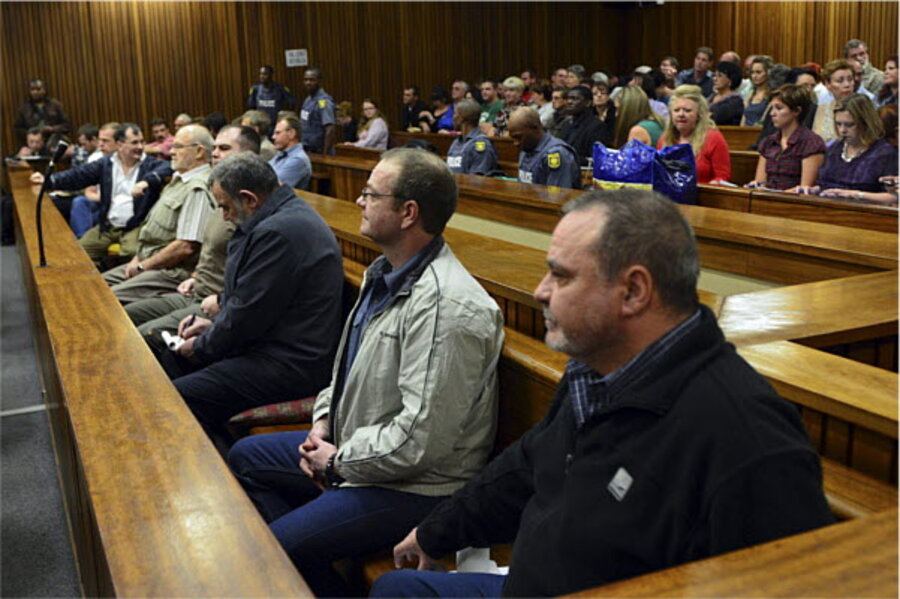Nelson Mandela assassination plotters face 35 years in prison
Loading...
| Johannesburg, South Africa
Some 21 members of the far-right Boeremag or "Farmer Force" on Tuesday were found guilty of treason by Pretoria's High Court for a foiled 2002 plot to overthrow the fledgling democracy.
Five members of the group who planted bombs in a mosque and in railway stations and petrol stations in the black township of Soweto – one of which killed a woman in her home – were also found guilty of culpable homicide.
The same five men hatched an impromptu plot to kill Nelson Mandela, the country’s first black president who had by then left office but who retained enormous influence, after they heard Mr. Mandela was planning to visit a rural school.
The men planted a bomb in a ditch to the side of a road that Mandela was scheduled to take. The bomb was rigged with fishing line that the men would use to detonate it when the former president passed by. Their plans were thwarted when South Africa's senior statesman (now at home recovering from an ailment) traveled to the engagement by helicopter.
The Boeremag trial began in May 2003 amid tight security in South Africa’s capital.
Some of the defendants, who range between 32 and 74, were doctors, academics, and members of the armed forces. All but one had no previous criminal convictions. Some said during the trial they launched the plot out of a fear of attacks on white farmers. Others cited political reasons. But most denied outright any involvement in criminal or treasonous behavior.
Those group members who admitted to a role in the plots asked to be tried as soldiers engaged in a legitimate armed struggle, comparing themselves to Mandela and his ANC colleagues who did at times wage a campaign of sabotage against the apartheid government. (Mandela later renounced violence as an answer to injustice.)
Their claim was rejected by the trial judge, Eben Jordaan, who described the plotters as "dishonest liars" who had sacrificed jobs and families and risked consciously plunging the country into "further chaos and bloodshed."
The five who plotted to kill Mandela received the maximum sentence of 35 years. But under South African law they could be freed in 25 years since they have spent almost 10 years on remand as the trial took place. Under the apartheid government, which sanctioned capital punishment, they would have faced execution.
According to local media, some of the families of the Farmer Force gasped and cried as the sentences were read out. One family member reportedly described the plot as “a storm in a teacup.”
The group’s ringleader, Mike du Toit, a former university lecturer, was found with a blueprint for the coup on his computer which described a Boer "Utopia" ruled over by a new military government appointed without democratic elections.
The blueprint suggested driving South Africa's black majority of about 40 million persons to Zimbabwe by lining the roads heading north with food parcels. It suggested sending the country’s 1.2 million Indians back to the South Asian subcontinent by boat, or in another plan, to pretend to make allies of them, and then shoot them once the coup achieved its aims.
Mr. du Toit discussed creating a "trigger" for the coup by blowing up a major dam, or shooting down a Boeing passenger plane to create a "World Trade Center situation." Other plots included assassinating Mandela and cutting electricity to major cities.
However, the group was infiltrated by intelligence agency moles who gave evidence against them at trial.
Frans Cronje, from South Africa's Institute of Race Relations, says any fears that the Boeremag's plot might win sympathy from disgruntled right-wingers in the country evaporated when their plans became known.
"It was clear that these guys were a bunch of clowns," he says.
But he warns that there has been a resurgence of "white, right-wing sympathy" in recent years, which could create new, unspecified threats. "I think years of crime and violence and black economic empowerment policies and a dearth of leadership in Afrikanerdom have allowed a situation to develop where there's a certain degree of bitterness in a certain section of the population."







